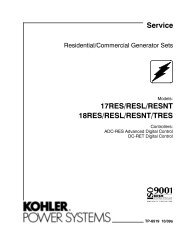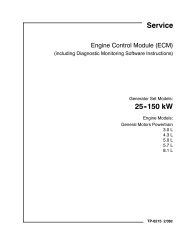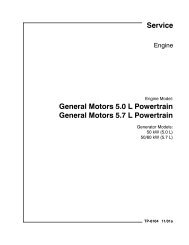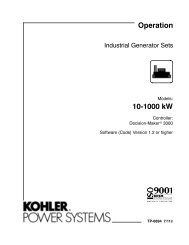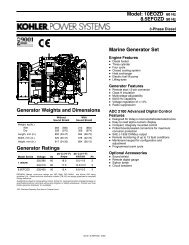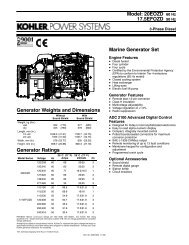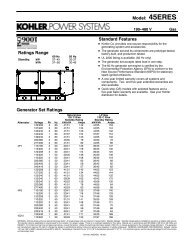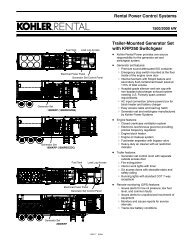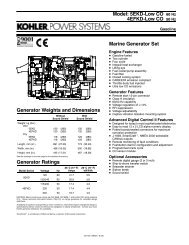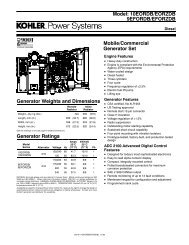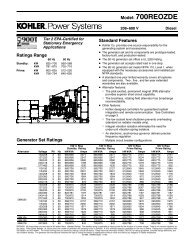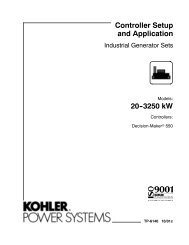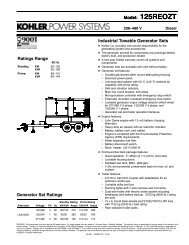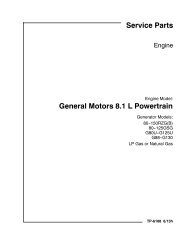Service Manual, General Motors 4.3L Engine (TP ... - Kohler Power
Service Manual, General Motors 4.3L Engine (TP ... - Kohler Power
Service Manual, General Motors 4.3L Engine (TP ... - Kohler Power
You also want an ePaper? Increase the reach of your titles
YUMPU automatically turns print PDFs into web optimized ePapers that Google loves.
6-172 Marine/Industrial <strong>4.3L</strong> <strong>Engine</strong><br />
Description and Operation<br />
<strong>Engine</strong> Component Description<br />
Balance Shaft<br />
The cast iron balance shaft is mounted in the crankcase<br />
above and in-line with the camshaft. A camshaft gear<br />
drives the gear attached to the balance<br />
shaft. The front end of the balance shaft is supported by a<br />
ball-type bearing. The rear end of the balance shaft uses<br />
a sleeve-type bearing.<br />
Camshaft<br />
The steel camshaft is supported by four bearings<br />
pressed into the engine block. The camshaft timing chain<br />
sprocket mounted to the front of the camshaft is driven<br />
by the crankshaft sprocket through a camshaft timing<br />
chain.<br />
Crankshaft<br />
The cast nodular iron crankshaft is supported by four<br />
crankshaft bearings. The number four crankshaft bearing<br />
at the rear of the engine is the end thrust bearing. The<br />
crankshaft bearings are retained by bearing caps that are<br />
machined with the engine block for proper alignment and<br />
clearances. The crankshaft position sensor reluctor ring<br />
has three lugs used for crankshaft timing and is<br />
constructed of powdered metal. The crankshaft position<br />
sensor reluctor ring has a slight interference fit onto the<br />
crankshaft and an internal keyway for correct positioning.<br />
Cylinder Heads<br />
The cast iron cylinder heads have one intake and one<br />
exhaust valve for each cylinder. A spark plug is located<br />
between the valves in the side of the cylinder head. The<br />
valve guides and seats are integral to the cylinder head.<br />
The <strong>4.3L</strong> heavy duty applications have pressed in<br />
exhaust valve seats. The valve rocker arms are<br />
positioned on the valve rocker arm supports and retained<br />
by a bolt.<br />
<strong>Engine</strong> Block<br />
The cast iron engine block has six cylinders arranged in a<br />
V shape with three cylinders in each bank. Starting at the<br />
front side of the engine block, the cylinders in the left<br />
bank are numbered 1-3-5 and cylinders in the right bank<br />
are numbered 2-4-6 (when viewed from the rear). The<br />
firing order of the cylinders is 1-6-5-4-3-2. The cylinders<br />
are encircled by coolant jackets.<br />
Exhaust Manifolds<br />
The cast iron exhaust manifolds direct exhaust gases<br />
from the combustion chambers to the exhaust system.<br />
The left side exhaust manifold has a port for the EGR<br />
valve inlet pipe.<br />
Intake Manifold<br />
The intake manifold is a two-piece design. The upper<br />
portion is made from a composite material and the lower<br />
portion is cast aluminum. The throttle body attaches to<br />
the upper manifold. The lower manifold has an exhaust gas<br />
recirculation (EGR) port cast into the manifold for mixture.<br />
The (EGR) valve bolts into the lower intake manifold. The<br />
Central Sequential Multiport Fuel Injection system uses<br />
multiple fuel injectors to meter and distribute fuel to each<br />
engine cylinder. The Central (SFI) is retained by a bracket<br />
bolted to the lower intake manifold. The fuel meter body also<br />
houses the pressure regulator. Metal inlet and outlet fuel<br />
lines and nylon delivery tubes connect to the Central (SFI)<br />
unit. The delivery tubes independently distribute fuel to each<br />
cylinder through nozzles located at the port entrance of<br />
each manifold runner where the fuel is atomized.<br />
Piston and Connecting Rod Assemblies<br />
The cast aluminum pistons use two compression rings and<br />
one oil control assembly. The piston is a low friction,<br />
lightweight design with a flat top and barrel shaped skirt.<br />
The piston pins are offset 0.9 mm (0.0354 in) toward the<br />
major thrust side (right side) to reduce piston slap as the<br />
connecting rod travels from one side of the piston to the<br />
other side after a stroke. The piston pins have a floating fit in<br />
the piston and are retained by a press fit in the connecting<br />
rod. The connecting rods are forged steel. The connecting<br />
rods are machined with the rod cap installed for proper<br />
clearances and alignments.<br />
Valve Train<br />
Motion is transmitted from the camshaft through the<br />
hydraulic roller valve lifters and the tubular valve pushrods<br />
to the roller type valve rocker arms. The roller type valve<br />
rocker arm pivots on a needle type bearing in order to open<br />
the valve. The valve rocker arms for each bank of cylinders<br />
are mounted to a one piece valve rocker arm support. Each<br />
valve rocker arm is retained on the valve rocker arm<br />
support and the cylinder head by a bolt. The hydraulic valve<br />
lifters keep all the parts of the valve train in constant<br />
contact. Each hydraulic valve lifter acts as an automatic<br />
adjuster and maintains zero lash in the valve train. This<br />
eliminates the need for periodic valve adjustment.<br />
Drive Belt System Description<br />
The drive belt system consists of the following components:<br />
• The drive belt<br />
• The drive belt tensioner<br />
• The drive belt idler pulley<br />
• The crankshaft balancer pulley<br />
• The accessory drive component mounting brackets<br />
• The accessory drive components<br />
– The power steering pump, if belt driven<br />
– The generator<br />
– The A/C compressor, if equipped<br />
– The engine cooling fan, if belt driven<br />
– The water pump, if belt driven<br />
– The vacuum pump, if belt driven<br />
– The air compressor, if belt driven<br />
2000 Marine/Industrial



